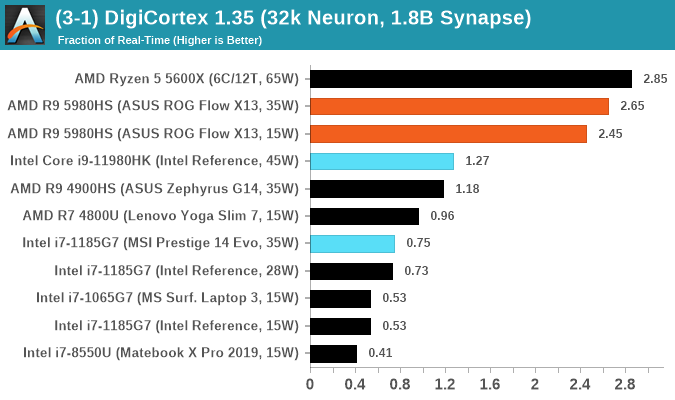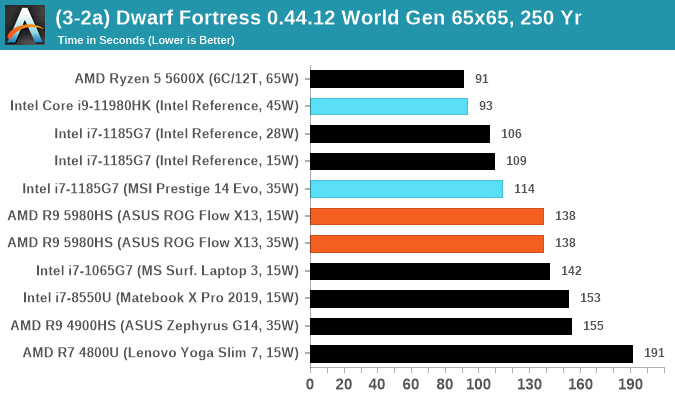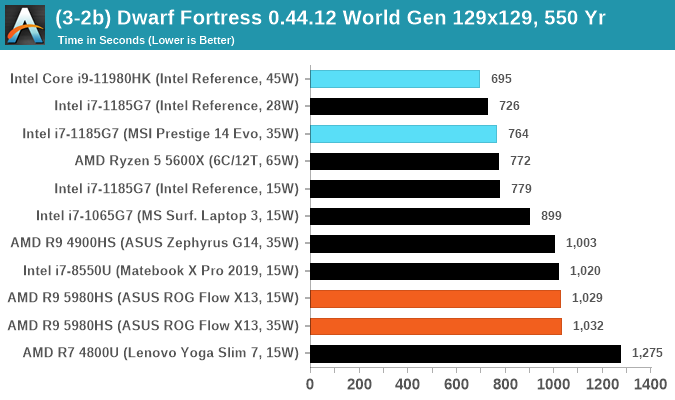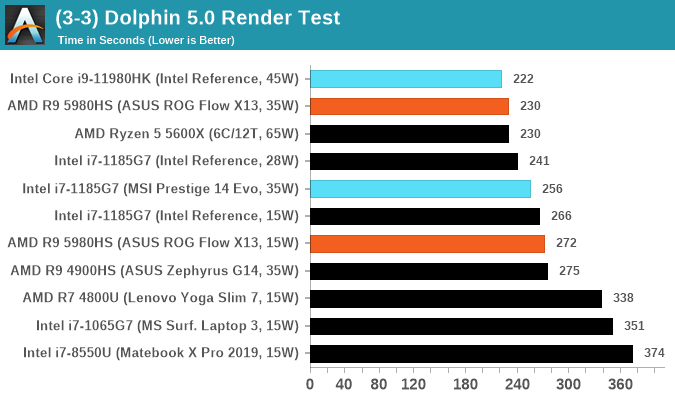Intel 11th Generation Core Tiger Lake-H Performance Review: Fast and Power Hungry
by Brett Howse & Andrei Frumusanu on May 17, 2021 9:00 AM EST- Posted in
- CPUs
- Intel
- 10nm
- Willow Cove
- SuperFin
- 11th Gen
- Tiger Lake-H
CPU Tests: Simulation
Simulation and Science have a lot of overlap in the benchmarking world, however for this distinction we’re separating into two segments mostly based on the utility of the resulting data. The benchmarks that fall under Science have a distinct use for the data they output – in our Simulation section, these act more like synthetics but at some level are still trying to simulate a given environment.
DigiCortex v1.35: link
DigiCortex is a pet project for the visualization of neuron and synapse activity in the brain. The software comes with a variety of benchmark modes, and we take the small benchmark which runs a 32k neuron/1.8B synapse simulation, similar to a small slug.
The results on the output are given as a fraction of whether the system can simulate in real-time, so anything above a value of one is suitable for real-time work. The benchmark offers a 'no firing synapse' mode, which in essence detects DRAM and bus speed, however we take the firing mode which adds CPU work with every firing.
The software originally shipped with a benchmark that recorded the first few cycles and output a result. So while fast multi-threaded processors this made the benchmark last less than a few seconds, slow dual-core processors could be running for almost an hour. There is also the issue of DigiCortex starting with a base neuron/synapse map in ‘off mode’, giving a high result in the first few cycles as none of the nodes are currently active. We found that the performance settles down into a steady state after a while (when the model is actively in use), so we asked the author to allow for a ‘warm-up’ phase and for the benchmark to be the average over a second sample time.
For our test, we give the benchmark 20000 cycles to warm up and then take the data over the next 10000 cycles seconds for the test – on a modern processor this takes 30 seconds and 150 seconds respectively. This is then repeated a minimum of 10 times, with the first three results rejected. Results are shown as a multiple of real-time calculation.

Dwarf Fortress 0.44.12: Link
Another long standing request for our benchmark suite has been Dwarf Fortress, a popular management/roguelike indie video game, first launched in 2006 and still being regularly updated today, aiming for a Steam launch sometime in the future.
Emulating the ASCII interfaces of old, this title is a rather complex beast, which can generate environments subject to millennia of rule, famous faces, peasants, and key historical figures and events. The further you get into the game, depending on the size of the world, the slower it becomes as it has to simulate more famous people, more world events, and the natural way that humanoid creatures take over an environment. Like some kind of virus.
For our test we’re using DFMark. DFMark is a benchmark built by vorsgren on the Bay12Forums that gives two different modes built on DFHack: world generation and embark. These tests can be configured, but range anywhere from 3 minutes to several hours. After analyzing the test, we ended up going for three different world generation sizes:
- Small, a 65x65 world with 250 years, 10 civilizations and 4 megabeasts
- Medium, a 127x127 world with 550 years, 10 civilizations and 4 megabeasts
- Large, a 257x257 world with 550 years, 40 civilizations and 10 megabeasts
DFMark outputs the time to run any given test, so this is what we use for the output. We loop the small test for as many times possible in 10 minutes, the medium test for as many times in 30 minutes, and the large test for as many times in an hour.


Dolphin v5.0 Emulation: Link
Many emulators are often bound by single thread CPU performance, and general reports tended to suggest that Haswell provided a significant boost to emulator performance. This benchmark runs a Wii program that ray traces a complex 3D scene inside the Dolphin Wii emulator. Performance on this benchmark is a good proxy of the speed of Dolphin CPU emulation, which is an intensive single core task using most aspects of a CPU. Results are given in seconds, where the Wii itself scores 1051 seconds.













229 Comments
View All Comments
gagegfg - Monday, May 17, 2021 - link
Where is the AMD "H" series? Like the 5980HX or the 5900H. It should have better multicore performance.Fulljack - Monday, May 17, 2021 - link
umm Ryzen 9 5980HS is "H" series...gagegfg - Tuesday, May 18, 2021 - link
HS <= 35WH / HX >= 45W
Linustechtips12#6900xt - Monday, May 17, 2021 - link
I find it hilarious that a desktop CPU 5600x maybe even the 57/5800x would be about the same if not better power consumption with better performance LOL especially performance per watt lol.Yojimbo - Monday, May 17, 2021 - link
Why? It's plugged in so what's the difference?Otritus - Wednesday, May 19, 2021 - link
I would assume because desktop cpus are typically tuned for performance at the cost of efficiency, and mobile processors are tuned for efficiency at the cost of performance. Power efficiency still does matter when plugged in for cooling purposes. Tiger lake needing a lot more power to deliver equal performance means higher temperatures, louder fans, or a more expensive cooling system.mode_13h - Thursday, May 20, 2021 - link
> I would assume because desktop cpus are typically tuned for performance at the cost> of efficiency, and mobile processors are tuned for efficiency at the cost of performance.
I think we've established that the H-series processors are basically desktop chips in a BGA package.
> Tiger lake needing a lot more power to deliver equal performance means higher
> temperatures, louder fans, or a more expensive cooling system.
Yup. Loud fans are why I disabled turbo on my H-series Dell Precision laptop that I use for work. The only thing I hate more than performance bogging down is screaming fans in my face. And yes, I have used pressurized air to blast any dust and debris from the cooling channels.
Also, a better cooling system tends to add bulk and weight.
cyrusfox - Monday, May 17, 2021 - link
One spelling comment, you have "GP Us" instead of "GPUs" on the first page, I use Text to speech, easy to catch it with that. Sorry to be the spelling guy. Thanks!cyrusfox - Monday, May 17, 2021 - link
Also on the last page should be"Where things aren't" not
"Where things are quite as straightforward, is the multi-threaded performance, as this is where we have to mention TDPs, power limits, and just the result of the Intel reference platform laptop we’ve tested today."
Thank you for the indepth review! Interesting stop gap to Alder lake, With apple in the market with a pending M2, going to be a very interesting space to watch.
Linustechtips12#6900xt - Monday, May 17, 2021 - link
Just wondering but could there be a comparison to an AMD 5800x or something like that just to put an idea on the power draw for the performance/ performance per watt? I was kinda curious after reading through the article a couple of times.